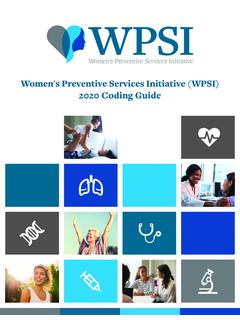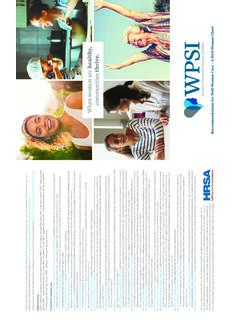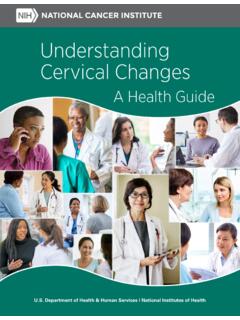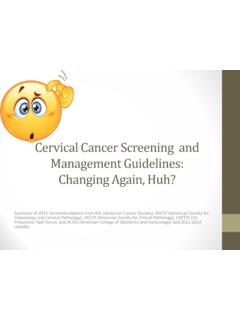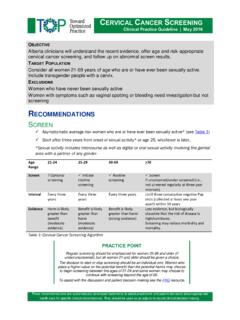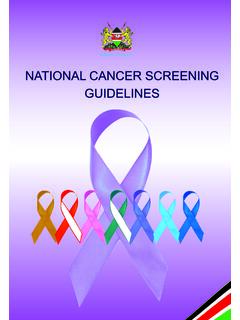Transcription of Women's Preventive Services Initiative (WPSI) 2021 …
1 Women's Preventive Services Initiative (WPSI)2021 Coding GuideScreening for cervical CancerRECOMMENDATION CODINGWPSI 2021 Coding GuideWomen's Preventive Services Initiative (WPSI) screening for cervical CancerClinical Recommendations: The women s Preventive Services Initiative recommends cervical cancer screening for average-risk women aged 21 to 65 years. For women aged 21 to 29 years, the women s Preventive Services Initiative recommends cervical cancer screening using cervical cytology (Pap test) every 3 years. Cotesting with cytology and human papillomavirus testing is not recommended for women younger than 30 years. women aged 30 to 65 years should be screened with cytology and human papillomavirus testing every 5 years or cytology alone every 3 years.
2 women who are at average risk should not be screened more than once every 3 Considerations: The women s Preventive Services Initiative recommends as a Preventive service, cervical cancer screening for average-risk women aged 21 to 65 years. For average-risk women aged 30 to 65 years, informed shared decision making between the patient and her clinician regarding the preferred screening strategy is who have received the human papillomavirus vaccine should be screened according to the same guidelines as women who have not received the recommendations are for routine screening in average-risk women and do not apply to women infected with human immunodeficiency virus, women who are immunocompromised because of another etiology (such as those who have received solid organ transplantation)
3 , women exposed to diethylstilbestrol in utero, or women treated for cervical intraepithelial neoplasia grade 2 or higher within the past 20 years. screening strategies for high-risk women are outside the scope of these cancer screening is not recommended for women younger than 21 years or those older than 65 years who have had adequate prior screening and are not otherwise at high risk of cervical cancer . Adequate prior negative screening is defined as documentation (or a reliable patient report) of three consecutive negative cytology results or two consecutive negative cotest results within the previous 10 years with the most recent test within the past 5 years.
4 cervical cancer screening is also not recommended for women who have had a hysterectomy with removal of the cervix and who do not have a history of a high-grade precancerous lesions (eg, cervical intraepithelial neoplasia grade 2 or grade 3 or cervical cancer within the past 20 years).NON-MEDICARE PAYERS: COLLECTION AND HANDLING OF PAP SMEAR SPECIMENThe American College of Obstetricians and Gynecologists Committee on Health Economics and Coding considers the collection of the Pap smear specimen, when performed, to be part of a pelvic examination. Therefore, it is not appropriate to code the collection of the specimen separately in addition to the E/M service CODING GUIDE 2021 WPSI 2021 Coding GuideSome payers reimburse for the handling of the Pap smear specimen when CPT code 99000 (Handling and/or conveyance of specimen for transfer from the physician's office to a laboratory) is reported.
5 Ask your insurer to verify coverage for this code in 99000 is intended to reflect the work involved in the preparation of a Pap smear specimen before sending it to the laboratory. In addition to the preparation of the Pap smear specimen, it may be used for other specimens. Typical work involved in this preparation may include centrifuging a specimen, separating serum, labeling tubes, packing the specimens for transport, filling out laboratory forms and supplying necessary insurance information and other considers this code to be an adjunctive service that further describes the basic service rendered. Therefore modifier 25 should not be appended to the E/M code code Q0091 ( screening Papanicolaou smear; obtaining, preparing and conveyance of cervical or vaginal smear to laboratory) was developed for a specific benefit within the Medicare program.
6 A limited number of payers reimburse for this code. You should verify coverage for this code including its specific application with the insurer. Be sure to obtain a payer reimbursement policy regarding this code in writing. Payers have requested takebacks from physician practices when this code was paid in no circumstances should a laboratory procedure code (eg, 88141 88177) be used to report the collection or handling of the Pap smear specimen. Doing so may result in the denial of the laboratory claim as a duplicate service. The patient then may be held responsible for the payment of the PAYERS: INTERPRETATION OF PAP SMEARIf the physician is billing for the interpretation of the Pap smear on behalf of the laboratory, he or she can report the appropriate laboratory code on the claim.
7 A modifier 90 must be added to the interpretation code (eg, 88150 90).The modifier 90 (Outside Laboratory Services ) indicates that the interpretation was performed by an outside laboratory and not in the physician s office. Modifier 90 is necessary because laboratory interpretation of a Pap smear is not a waived office-based test under the Clinical Laboratory Improvement Amendments of 1988 (CLIA) regulations. The modifier also informs the payer that a fee should not be paid to the laboratory in addition to the one paid to the physician s a physician is reporting interpretation of Pap smears on behalf of the laboratory, he or she should find out which code (eg, thin prep, manual screening , computer-assisted rescreening, etc.)
8 Is appropriate. The physician also should be aware of state regulations that may prohibit physicians from billing on behalf of the information about CLIA regulations is available at the CMS website: The website includes a categorization of tests and information about how to apply for a CLIA for Interpretation of Pap SmearsHealth insurers vary, from contract to contract, in their coverage of Preventive Services and interpretation of Pap smear. Coverage may depend upon whether the Pap smear is a screening or diagnostic test. Noncovered Services are the responsibility of the CODINGWPSI 2021 Coding GuideScreening Pap smears are performed in the absence of illness, disease, or symptoms.
9 Most health plans around the country provide coverage for an annual screening Pap CODING OPTIONS Encounter for gynecological exam with abnormal findings Encounter for gynecological exam without abnormal Encounter for screening for malignant neoplasms of Encounter for screening for malignant neoplasm of vaginaZ08 Encounter for follow-up examination after completed treatment for malignant neoplasm (Used for follow-up vaginal Pap smear [status post hysterectomy for malignant condition])Human Papillomavirus ScreeningCMS will cover screening for cervical cancer with human papillomavirus (HPV) cotesting under the following conditions: Human papillomavirus testing once every 5 years for asymptomatic beneficiaries aged 30 to 65 years in conjunction with the Pap smear test with the appropriate Food and Drug Administration (FDA)- approved/cleared laboratory tests, used consistent with FDA-approved labeling, and in compliance with CLIA service is reported with the following HCPCS code:G0476 Infectious agent detection by nucleic acid (DNA or RNA).
10 Human papillomavirus (HPV), high-risk types (eg, 16, 18, 31, 33, 35, 39, 45, 51, 52, 56, 58, 59, 68) for cervical cancer screening , must be performed in addition to Pap smear The following diagnosis codes are reported for this Encounter for screening for human papillomavirus (HPV), AND Encounter for gynecological exam (general)(routine) with abnormal findings, OR Encounter for gynecological exam (general)(routine) without abnormal findings.
